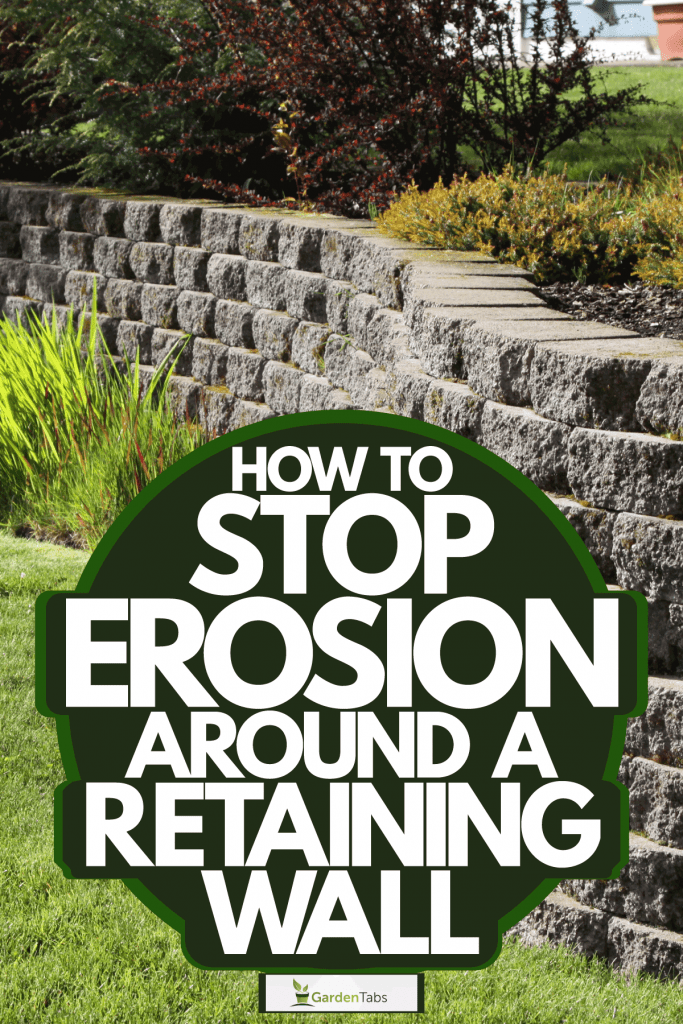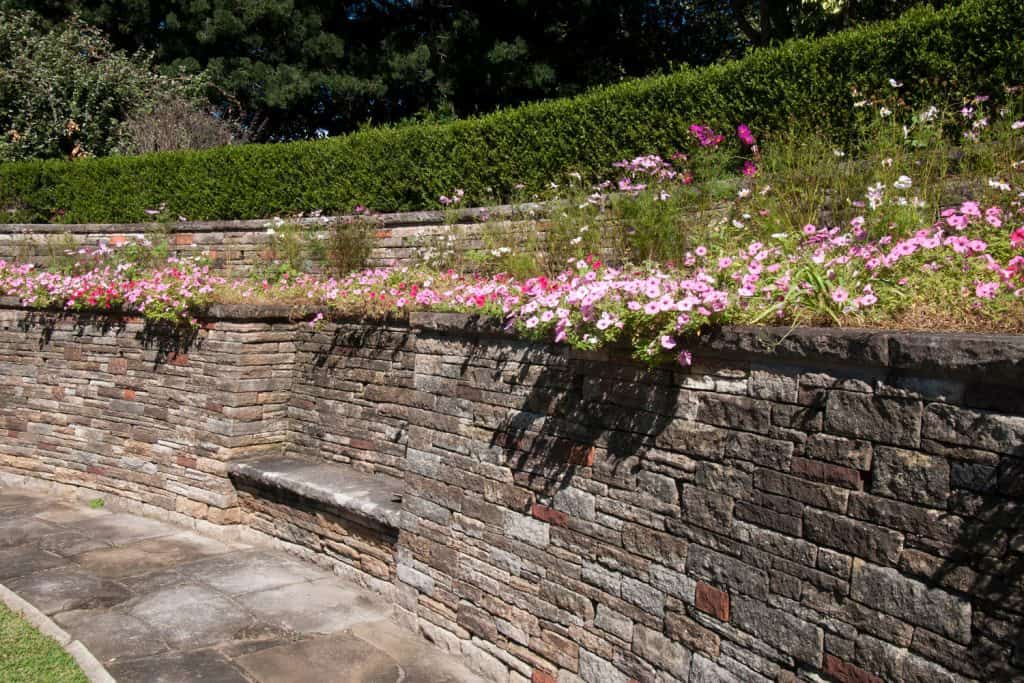Did you build a retaining wall to help with erosion in your garden only to find that soil is still eroding around the retaining wall? If this happened to you, it could feel like your hard work was wasted. But, we are here to show you how to stop erosion around retaining walls, so your garden can thrive.
The purpose of a retaining wall is to prevent erosion and support soil. If erosion is still happening around the retaining wall, there are a few ways to help with this problem:
- Plant ground covers
- Mulch exposed garden areas
- Reroute garden drainage system
- Backfill the wall with new material
- Build a new wall
If there is extreme erosion and the retaining wall is old, building a new wall may be the only way to stop the erosion.
Each of these solutions can help with stopping erosion around a retaining wall. You probably still have questions about the above methods and how they work. Keep reading for more information about retaining walls and these specific solutions.

How Do You Fix Erosion On A Retaining Wall?
Retaining walls are designed to prevent erosion, not cause it. When you notice erosion around your retaining wall, there is a problem. Let's take a look at some steps you can take to fix erosion near your retaining wall.
1. Plant Ground Covers
Planting ground covers is an easy first step to fix the erosion around your retaining wall. Ground cover plants naturally spread out over wide areas at a fast pace and grow low. Most of the time, they are easy to take care of and stay green all year. Most importantly, they decrease erosion. Ground cover plants can quickly fill in gaps in your garden and around your retaining wall.

Planting ground covers to prevent erosion is a simple process. Look for bare patches of soil above and below your retaining wall. Then plant the ground covers in those spots. Their quick-growing roots will spread and anchor the soil in place. This means next time it rains; the soil is less likely to erode. In addition, their roots suck up excess water, therefore, decreasing the amount of fluid that flows into and around your retaining wall.
If you have clay soil and are looking for gound covers, read this article: 12 Ground Cover Plants For Clay Soil.
2. Mulch Exposed Garden Areas
Mulch is also a simple way to reducing erosion. Many factors contribute to soil erosion. The biggest factor in garden soil erosion is running water. Mulch helps reduce the amount of running water flowing through your garden after heavy rains. It also protects the topsoil from drying out. Dry soil is actually more prone to erosion than moist soil, so this is a significant benefit of mulching.
Take a stroll through your garden and around your retaining wall. Look for exposed soil areas. Then, put a thick layer of mulch in these spots. This reduces the amount of water flowing through your retaining wall, and hopefully, it helps with your erosion problem.
PlantBest Mega Mulch
Here is an all-natural mulch perfect for your garden. It's made from coconut fiber and coir chunks to help reduce watering and prevent erosion.
Click here to view it on Amazon.
If you are worried about attracting termites once you mulch, read this article: Does Mulch Attract Termites? [And How To Protect Your Home].
3. Reroute Drainage System
Erosion near retaining walls may occur due to large amounts of water seeping from the bottom of the wall. Even if your retaining wall has a drainage system, it can only hold so much water. Rerouting your garden's drainage system is an excellent way to slow down/limit water flow going directly to your retaining wall.
To reroute your garden drainage system, you can dig small drainage channels into the landscape. This gives water multiple passageways to flow through, and it provides your retaining wall time to drain correctly before more liquid reaches it.
4. Backfill The Retaining Wall
In many circumstances, erosion near retaining walls happens because of an improper drainage system. An essential part of all retaining walls is using a proper backfill substance. If you tried the above solutions and nothing has worked so far, you might have to renovate your current retaining wall by adding a better backfill.
The backfill of a retaining wall is the dirt/organic matter directly behind the wall. This section of retaining walls needs to have great draining, so water doesn't pool near the edge. If you don't have a properly draining aggregate in this section of your wall, then you need to do some digging.
First, measure 12 inches out from your wall. Then, try to remove as much dirt as you can in this section. Once you have this space cleared, fill it with a granular substance. Gravel 1/2 to 3/4 in diameter is the ideal material to backfill with. Top it off with native soil for a cohesive look.
5. Build A New Wall
Sometimes, the only way to stop erosion next to a retaining wall is to build a new one. It can be challenging to backfill or install a drainage system to a retaining wall without destroying its integrity. Because of this, many people choose to reconstruct instead of renovating.
If you rebuild because of erosion, we highly recommend building a terraced retaining wall. Having multiple staggered retaining walls with green space in between helps water drain more slowly. In addition, the extra plant coverage creates a natural system to uptake excess standing water in the walls. This slow draining system prevents water from rushing through your garden while taking the fertile topsoil with it.
If you want to create a walled garden along with your new retaining wall, check out this article: 18 Best Cascading Plants For A Wall Garden.
How Do You Keep A Retaining Wall From Washing Out?
Proper drainage is the key to keep a retaining wall from washing out. Without a good drainage system, water builds up at the base of the retaining wall. This puts loads of pressure on the bottom tiers of the wall. This high pressure can cause the wall to wash out and crumble.
To prevent washout, make sure to include a proper drainage system when you build your retaining wall. Include a drainage pipe at the bottom, drainage wells, and use a porous material for the backfill. You can even put landscaping fabric between the wall and the backfill for even more stability. Also, make sure the wall is constructed on a level surface, so no pressure points are created.

Agtek Landscape Fabric
This landscaping fabric would make a great addition to your retaining wall. The durable, high-density material help with the slow drainage of water to prevent erosion.
Click here to view it on Amazon.
What Is The Best Base For A Retaining Wall?
The best base for a retaining wall is a layer of crushed stone or gravel 6 to 8 inches deep. You can top this with a layer of sand for an even stronger base. Gravel helps the wall stay level and handles freeze/thaw conditions better than native dirt or other materials.
How Much Weight Can A Retaining Wall Hold?


The amount of weight a retaining wall holds depends on the size and type of wall. Gravity retaining walls are the most common in gardens. An average-sized, gravity retaining wall can hold up to 20 tons of soil. Other types of retaining walls, like sheet piling and anchored, hold much more weight. However, these types are not typically used in backyards to support a garden.
How Do You Reinforce A Rock Retaining Wall?
There are a few ways to reinforce a rock retaining wall. Here are some of the best techniques for making your rock wall stronger:
- Use concrete or another strong substance to fill in gaps between rocks
- Install rebar poles from the base during initial construction
- Add a layer of wire mesh between backfill and wall
Any of these practices will make your retaining wall even stronger.
Say Goodbye To Erosion
Erosion in your garden is frustrating. It's even more frustrating when erosion happens near your retaining wall. But, now you know some solutions to this problem. First, plant some ground covers and layer mulch in exposed soil areas to encourage water retention and slow drainage. If this doesn't work, you can try more drastic measures like rerouting the drainage system or changing the retaining wall backfill. Either way, remember that the key to an erosion-free retaining wall is proper drainage.



My retaining wall was built well it is a cinder block wall. With the soil made of tightly packed rock so the wall is under much load at all. Over many years though the back of the wall which used to have a foot or so clear above the ground has filled with loose rock caused by many covey of quail that have moved in with nests all along the hillside. Rocks knocked loose now roll down and launch off the topped of the wall right into the car park. Not much will easily grow on the hillside and if I build the wall higher I worry it will simply fill in again. The only thing I can think of is to terrace all the way up so soil doesn’t have momentum to erode further.